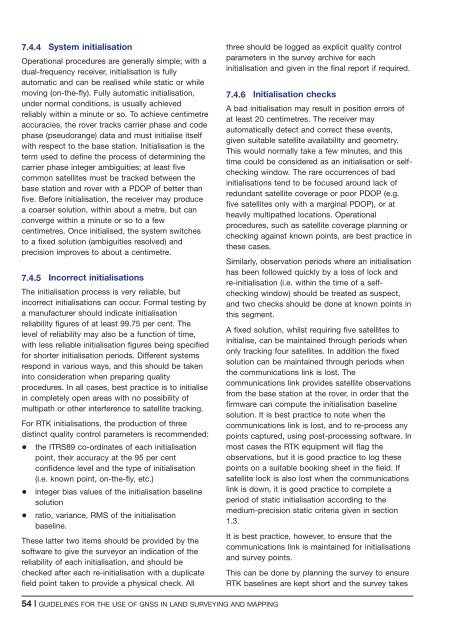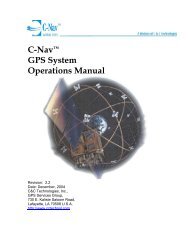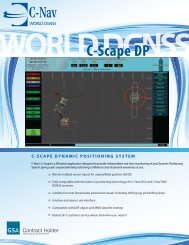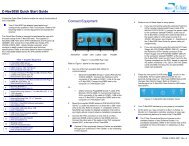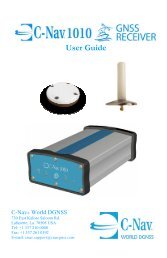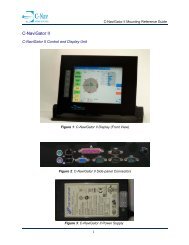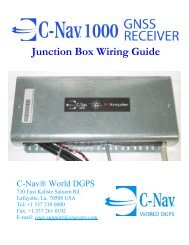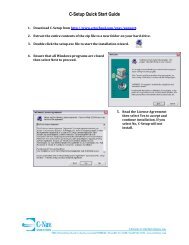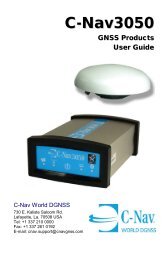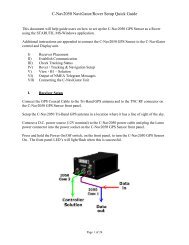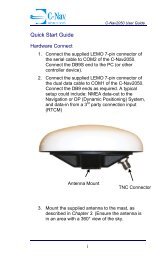Guidelines for the use of GNSS in surveying and mapping
Guidelines for the use of GNSS in surveying and mapping
Guidelines for the use of GNSS in surveying and mapping
Create successful ePaper yourself
Turn your PDF publications into a flip-book with our unique Google optimized e-Paper software.
7.4.4 System <strong>in</strong>itialisation<br />
Operational procedures are generally simple; with a<br />
dual-frequency receiver, <strong>in</strong>itialisation is fully<br />
automatic <strong>and</strong> can be realised while static or while<br />
mov<strong>in</strong>g (on-<strong>the</strong>-fly). Fully automatic <strong>in</strong>itialisation,<br />
under normal conditions, is usually achieved<br />
reliably with<strong>in</strong> a m<strong>in</strong>ute or so. To achieve centimetre<br />
accuracies, <strong>the</strong> rover tracks carrier phase <strong>and</strong> code<br />
phase (pseudorange) data <strong>and</strong> must <strong>in</strong>itialise itself<br />
with respect to <strong>the</strong> base station. Initialisation is <strong>the</strong><br />
term <strong>use</strong>d to def<strong>in</strong>e <strong>the</strong> process <strong>of</strong> determ<strong>in</strong><strong>in</strong>g <strong>the</strong><br />
carrier phase <strong>in</strong>teger ambiguities; at least five<br />
common satellites must be tracked between <strong>the</strong><br />
base station <strong>and</strong> rover with a PDOP <strong>of</strong> better than<br />
five. Be<strong>for</strong>e <strong>in</strong>itialisation, <strong>the</strong> receiver may produce<br />
a coarser solution, with<strong>in</strong> about a metre, but can<br />
converge with<strong>in</strong> a m<strong>in</strong>ute or so to a few<br />
centimetres. Once <strong>in</strong>itialised, <strong>the</strong> system switches<br />
to a fixed solution (ambiguities resolved) <strong>and</strong><br />
precision improves to about a centimetre.<br />
7.4.5 Incorrect <strong>in</strong>itialisations<br />
The <strong>in</strong>itialisation process is very reliable, but<br />
<strong>in</strong>correct <strong>in</strong>itialisations can occur. Formal test<strong>in</strong>g by<br />
a manufacturer should <strong>in</strong>dicate <strong>in</strong>itialisation<br />
reliability figures <strong>of</strong> at least 99.75 per cent. The<br />
level <strong>of</strong> reliability may also be a function <strong>of</strong> time,<br />
with less reliable <strong>in</strong>itialisation figures be<strong>in</strong>g specified<br />
<strong>for</strong> shorter <strong>in</strong>itialisation periods. Different systems<br />
respond <strong>in</strong> various ways, <strong>and</strong> this should be taken<br />
<strong>in</strong>to consideration when prepar<strong>in</strong>g quality<br />
procedures. In all cases, best practice is to <strong>in</strong>itialise<br />
<strong>in</strong> completely open areas with no possibility <strong>of</strong><br />
multipath or o<strong>the</strong>r <strong>in</strong>terference to satellite track<strong>in</strong>g.<br />
For RTK <strong>in</strong>itialisations, <strong>the</strong> production <strong>of</strong> three<br />
dist<strong>in</strong>ct quality control parameters is recommended:<br />
+ <strong>the</strong> ITRS89 co-ord<strong>in</strong>ates <strong>of</strong> each <strong>in</strong>itialisation<br />
po<strong>in</strong>t, <strong>the</strong>ir accuracy at <strong>the</strong> 95 per cent<br />
confidence level <strong>and</strong> <strong>the</strong> type <strong>of</strong> <strong>in</strong>itialisation<br />
(i.e. known po<strong>in</strong>t, on-<strong>the</strong>-fly, etc.)<br />
+ <strong>in</strong>teger bias values <strong>of</strong> <strong>the</strong> <strong>in</strong>itialisation basel<strong>in</strong>e<br />
solution<br />
+ ratio, variance, RMS <strong>of</strong> <strong>the</strong> <strong>in</strong>itialisation<br />
basel<strong>in</strong>e.<br />
These latter two items should be provided by <strong>the</strong><br />
s<strong>of</strong>tware to give <strong>the</strong> surveyor an <strong>in</strong>dication <strong>of</strong> <strong>the</strong><br />
reliability <strong>of</strong> each <strong>in</strong>itialisation, <strong>and</strong> should be<br />
checked after each re-<strong>in</strong>itialisation with a duplicate<br />
field po<strong>in</strong>t taken to provide a physical check. All<br />
three should be logged as explicit quality control<br />
parameters <strong>in</strong> <strong>the</strong> survey archive <strong>for</strong> each<br />
<strong>in</strong>itialisation <strong>and</strong> given <strong>in</strong> <strong>the</strong> f<strong>in</strong>al report if required.<br />
7.4.6 Initialisation checks<br />
A bad <strong>in</strong>itialisation may result <strong>in</strong> position errors <strong>of</strong><br />
at least 20 centimetres. The receiver may<br />
automatically detect <strong>and</strong> correct <strong>the</strong>se events,<br />
given suitable satellite availability <strong>and</strong> geometry.<br />
This would normally take a few m<strong>in</strong>utes, <strong>and</strong> this<br />
time could be considered as an <strong>in</strong>itialisation or selfcheck<strong>in</strong>g<br />
w<strong>in</strong>dow. The rare occurrences <strong>of</strong> bad<br />
<strong>in</strong>itialisations tend to be foc<strong>use</strong>d around lack <strong>of</strong><br />
redundant satellite coverage or poor PDOP (e.g.<br />
five satellites only with a marg<strong>in</strong>al PDOP), or at<br />
heavily multipa<strong>the</strong>d locations. Operational<br />
procedures, such as satellite coverage plann<strong>in</strong>g or<br />
check<strong>in</strong>g aga<strong>in</strong>st known po<strong>in</strong>ts, are best practice <strong>in</strong><br />
<strong>the</strong>se cases.<br />
Similarly, observation periods where an <strong>in</strong>itialisation<br />
has been followed quickly by a loss <strong>of</strong> lock <strong>and</strong><br />
re-<strong>in</strong>itialisation (i.e. with<strong>in</strong> <strong>the</strong> time <strong>of</strong> a selfcheck<strong>in</strong>g<br />
w<strong>in</strong>dow) should be treated as suspect,<br />
<strong>and</strong> two checks should be done at known po<strong>in</strong>ts <strong>in</strong><br />
this segment.<br />
A fixed solution, whilst requir<strong>in</strong>g five satellites to<br />
<strong>in</strong>itialise, can be ma<strong>in</strong>ta<strong>in</strong>ed through periods when<br />
only track<strong>in</strong>g four satellites. In addition <strong>the</strong> fixed<br />
solution can be ma<strong>in</strong>ta<strong>in</strong>ed through periods when<br />
<strong>the</strong> communications l<strong>in</strong>k is lost. The<br />
communications l<strong>in</strong>k provides satellite observations<br />
from <strong>the</strong> base station at <strong>the</strong> rover, <strong>in</strong> order that <strong>the</strong><br />
firmware can compute <strong>the</strong> <strong>in</strong>itialisation basel<strong>in</strong>e<br />
solution. It is best practice to note when <strong>the</strong><br />
communications l<strong>in</strong>k is lost, <strong>and</strong> to re-process any<br />
po<strong>in</strong>ts captured, us<strong>in</strong>g post-process<strong>in</strong>g s<strong>of</strong>tware. In<br />
most cases <strong>the</strong> RTK equipment will flag <strong>the</strong><br />
observations, but it is good practice to log <strong>the</strong>se<br />
po<strong>in</strong>ts on a suitable book<strong>in</strong>g sheet <strong>in</strong> <strong>the</strong> field. If<br />
satellite lock is also lost when <strong>the</strong> communications<br />
l<strong>in</strong>k is down, it is good practice to complete a<br />
period <strong>of</strong> static <strong>in</strong>itialisation accord<strong>in</strong>g to <strong>the</strong><br />
medium-precision static criteria given <strong>in</strong> section<br />
1.3.<br />
It is best practice, however, to ensure that <strong>the</strong><br />
communications l<strong>in</strong>k is ma<strong>in</strong>ta<strong>in</strong>ed <strong>for</strong> <strong>in</strong>itialisations<br />
<strong>and</strong> survey po<strong>in</strong>ts.<br />
This can be done by plann<strong>in</strong>g <strong>the</strong> survey to ensure<br />
RTK basel<strong>in</strong>es are kept short <strong>and</strong> <strong>the</strong> survey takes<br />
54 | GUIDELINES FOR THE USE OF <strong>GNSS</strong> IN LAND SURVEYING AND MAPPING


